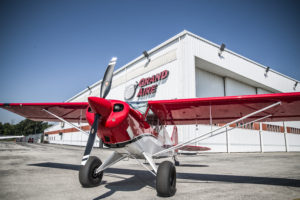Prepping Your Plane for Warmer Weather Flying
Now that the snow is gone (we hope), and the daily temperature is beginning to climb, our thoughts turn to spring and summer flying!
Ok, so who’s kidding who? We’ve been thinking about going wheels up for months.
But before you do, be sure to take the time to properly prepare your airplane. This is vitally important as an aircraft can significantly deteriorate during a period of inactivity. To ensure a safe and smooth flying season, review the following checklist.
A Thorough Cleaning
Cleaning the plane both inside and out is not simply for aesthetic purposes. This task also allows for a close, detailed inspection.
Start by washing the outside to remove any bugs, tar or oil. Give the wing flaps and tail fins a little extra attention to be sure no dirt or foreign matter is present that can interfere with their normal functions.
When washing the windows, use an up and down rather than circular motion to prevent scratches. Once clean, give the aircraft a good waxing to help protect the paint.
Next, focus on the Plexiglas of the aircraft. Use plenty of water and wash with your bare hand to avoid rubbing any debris into the glass and possibly causing scratches. Using a soft, dry cloth, apply a Plexiglas polish made specifically for aircrafts.
Don’t forget the engine. Use a little 100LL and a rag to remove any built-up grease and oil that may be lurking under the cowling.
Once finished with the outside, remove everything from inside the plane. Yes, everything. Pens, charts, batteries, rags, flashlights, etc. Give it a thorough vacuuming, including all panels and windows.
Time for Inspection
Start with a full walk around the aircraft. Look for hairline cracks or structural damage on the fuselage and wings. Check door and window seals to make sure they aren’t dried out or corroded. Also inspect the air intake and cowling, stall warning vent, pilot tube and static ports to be sure they aren’t clogged.
Confirm that nothing is loose or damaged in the propeller assembly, wing flaps, tail fins, landing gear and landing gear doors. Look for leaks or corrosion in each system of your plane. This includes all fuel hoses, injectors, gaskets, rubber diaphragms, etc.
Check the fuel drains for any water or foreign material. Remove the fuel filter, clean and replace. Also check for condensation in the fuel tanks.
Since tires can lose pressure over time, test to make sure all are at their recommended psi. Look them over carefully for signs of extreme tread wear or bald spots. Also check the wheel brake assembly for leaks and strut condition.
Routine Maintenance
Remove the battery from the aircraft to properly inspect it and replace if it’s in questionable condition. Take the time to look over all electrical components such as circuits, circuit breakers, wiring at terminals, radio and antenna.
Lastly, it’s a good idea to do an oil change before your first spring flight even if you did one when storing your plane for the winter. It may seem a bit redundant, but this small bit of maintenance can possibly save you from future repairs that are sure to be costly.
Head for the Sky
Once you’ve checked off all the boxes on your list, it’s time to put those wheels up and get your head in the clouds! If your travels bring you to KTOL, know that our FBO is here to assist you with fueling or hangar space, if needed. Contact us at 1-800-70-GRAND.
